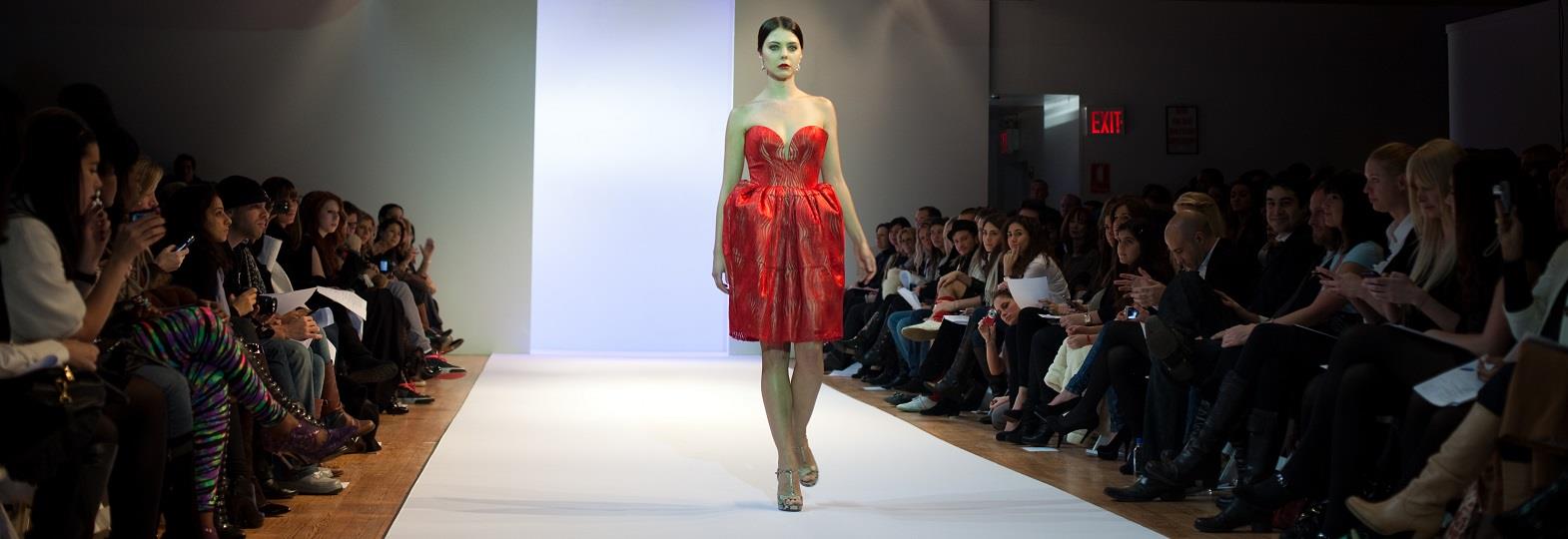A fashion show is a promotional event where new fashion design collections of a designer are presented on real people and shown to potential customers and industry professionals. The merchandise collections are worn by the real persons, generally termed as ‘models’, giving a true presentation of how they look when worn. The models walk the ramp or ‘catwalk’ on the stage surrounded by the audience who are generally industrial professionals and customers. A fashion show is more entertaining because it shows how to achieve certain looks, how to wear the latest styles, what to wear, and when to wear them. It also exhibits the related coordinated accessories or ensembles.
A fashion show can also be an effective promotional or fashion forecasting presentation tool for new daring fashion merchandise that could give an instant response and lead to a sale. The show may be conducted by a single designer, group of designers, a designer house, retailers, associations, institutions etc. Sometimes these shows are accompanied with other events like trade shows, fairs, exhibitions, inaugurations etc. Normally, fashion shows are conducted in the evening, and last for a few hours. Admission for the show is usually on invitation, and sometimes an entrance fee is collected from the potential customers or public to prevent copying without buying. This admission fee is called ‘Caution Fee’, and if a customer makes a purchase, the fee is refunded
Planning
Proper and practically feasible planning is a must for any fashion show. The well-prepared planning includes:
- Setting the goals
- Deciding on essential requirements that need to be established for planning
- Planning every step
- Reviewing the plan for deviations and alternative solutions to those deviations
- Organising the manpower
- Allocating, directing and delegating responsibilities and authorities
- Communicating the information and instructions so that everyone knows what needs to be done and what each person’s role would be
- Controlling all the activities, making sure that everything is going as per the plan and making proper alternative course of action for any deviations that might occur.
Budgeting
The budgeting for fashion show is based on the previous year’s expenses, new commitments by the management, and creative ideas that develop later. The budget is prepared one year in advance for a six-month period. It is always advisable to have a checklist of expense items to make the budget more realistic. If the response to the show is favourable, sometimes ‘just-in-case’ shows are planned due to potential time constraints in preparing the proposed shows, leading to an upward revision of the budget. The major expenses for any fashion show are the payment to models, venue and the digital audio and video setups. The other expenses include those related to advertising, photographers etc. Sometimes, outside sponsors may be willing to pay some expenses as part of their company promotions. To reduce the expenses of a fashion show, sponsorship from companies related to the fashion industry is advisable.
Selection of the Location
The selection of the location and venue is a very important factor to be considered while preparing for fashion shows. The location should be a familiar one with easy access from various city locations. It may be an indoor or outdoor event depending on the season, climate, appropriateness to the design collection etc. Outdoor shows are encouraged during the summer or non-rainy seasons, whereas indoors are recommended during the winter or rainy seasons. Similarly, if the collection is related to lingerie wear or beachwear, then the show can be conducted at a beach resort.
A fashion show may be carried out within a store or outside of the store. Both locations have their own merits and demerits. In-store fashion shows are conducted inside the store, bringing customers closer to the merchandise, and consequently, they have a better view of the clothes and sometimes can touch and feel them. Customers can make immediate purchases if they like the items. However, this may require additional salespeople on that particular day to handle the expected influx of customers. Additionally, in-store shows may disrupt the sales of other departments, if proper space is not provided. Conducting a fashion show in the evening can be advantageous for a specialty store as it would not disturb the day’s sales and is convenient for customers who work during the day.
Out-of-the-store fashion shows are held in hotel ballrooms, auditoriums, theatres, country clubs etc. The size of the space for the fashion show depends on the expected audience. The selection of the location should be done carefully, considering facilities like lighting, a green room for changing clothes and doing makeup for the participating models etc. It is essential to create a walkway or ramp so that viewers can see the fashion clearly, although this can be expensive.
Timing of the Show
The timing is another crucial factor in attracting a good audience. It includes the month of the year, the week of the month, the day of the week and the time of the day which should be considered thoughtfully for all the fashion shows.
The decision to choose the best time of the year should correspond with the arrival of new merchandise in the store. The show should be arranged well in advance before the customers make their purchases somewhere else. Normally, fashion shows are conducted based on seasons like fall/winter, summer/autumn, or on special events and festivals like back-to-school, Christmas, New Year, Easter etc.
To decide the best day of the week for conducting a fashion show, it is important to observe the behaviour of the local population, such as the day of the week on which they make most of their purchases. The store organising the show can examine its records to assess the size of previous audiences and gather additional information from external sources.
The timing of day for the show may depend on the target customers. For example, for working professionals, the show may be scheduled after work hours, whereas for non-working mothers, it may be set before 2:00 pm. A designer show may be scheduled for late morning, followed by a luncheon. Special fashion shows, those accompanied with a trade fair and exhibition, may be conducted in the evening by 8:00 pm.
Selection of Models
Models are the individuals who wear the fashion merchandise presented to the audience. Appropriate selection of models is necessary for the success of a fashion show. The attributes of a model, such as walking style, hand placement, posture, attitudes, complexion, expression of the face, and hairstyle, should be suitable for the particular style or design of the merchandise. Other attributes like self-confidence and a positive attitude should also be evaluated before selecting a model. Models should be able to wear clothes from the inventory and fit into more than one size. They should take care of the clothes by keeping them clean, neat, and properly protected from any damage.
Sources for models are colleges, friends, employees, dancers and some special agencies. Different types of models can be chosen based on age, gender, colour, nationality, size etc. A small fashion show may need around five to six models, while for a larger one twelve to fifteen models can be required.
Design Collections
The collections which are going to be presented in the fashion show should be checked well in advance for missing looks, defects, workmanship etc. The selected size should fit most of the models. A list of the merchandise should be made, and the selected one should appeal to the show audience. This list may be used to prepare the commentary for the show.
Selection of the Set or Stage Design
The stage design should be made according to the theme of the fashion show. It should be attractive and should not subdue the merchandise being shown. The considerations for lighting, such as the type, level, place and colour, are also very important. Too much lighting can create glare, while dull lighting might lead to poor visibility. The backdrop of the stage may be displayed with the name(s) of the store or designer or sponsors.
Selection of Music
Music plays a psychological role in the mind of the audience at the show. It may evoke emotions and help establish a connection between the customers and the merchandise. The selected music should be familiar so that customers can identify with it and feel a part of the event. The sound should also be mild enough to not disrupt the commentary of the customers. The selection of rhythm may depend on the design collection or theme of the show. If the merchandise collection is classical, classical music can be used, while for the latest fashion, western music may be more suitable. Special music can be sourced from various collections, and sometimes a new tape is prepared specifically for the fashion show.
Preparation of Commentary
Commentary for a fashion show is necessary for various reasons, but its main purpose is to inform the audience about the details of the merchandise being shown. The commentary should begin with a welcome note and an introduction to the theme of the show, generating anticipation and enthusiasm among the audience. When describing each costume, it should highlight the relation of the costume to the theme and attractively point out the features of the merchandise. The commentary captures the attention of the audience, allowing them to concentrate more on the displayed merchandise.
A good commentator should possess the following qualities:
- Resonance of voice: a vibrant voice that reaches all ears.
- Clarity of speech: every word should be clear and easily understood.
- Performance under pressure: ability to withstand pressure.
- Flexibility: ability to improvise and create a more natural performance instead of following a word-by-word prepared script.
- Knowledge: knowledge about the fashion being presented.
A rehearsal is always necessary for any fashion event, particularly for big fashion shows. During the rehearsal, all fashion merchandise and accessories should be tried on and run through in a planned sequence. Special attention should be given to the walk for each scene, ensuring that the models adapt to the rhythm of the music. The placement, movement, and lineup of the models on the stage should be decided, and the timing for each walk should be finalised.
Other Factors
There are some other factors to consider while organising a fashion show, which include seating arrangements for the audience; photography; invitations to regular customers, industry professionals etc; booking of seats in advance; security; and hospitality.











Comments